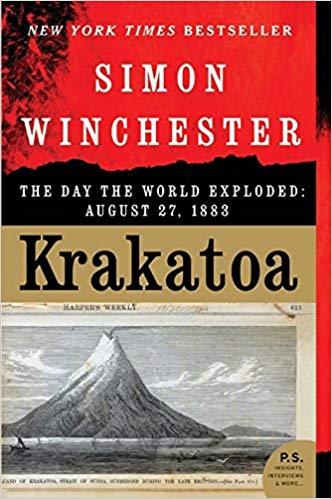
Krakatoa August 27, 1883, The Day the World Exploded is Simon Winchester’s title for his most fascinating book. It’s a bit of over speak to be sure, the world didn’t explode, but it must have seemed like it for many. Shock waves were recorded travelling eight times around the world. Nearly 40,000 people died. Sunsets all over the globe were terrific for three years after the explosion happened because of the dust in the air. Even in America, fire brigades were assembled on a couple of occasions to fight what looked to be distant fires on the horizon. The red glow turned out to be a Krakatoa caused illusion made by dust and sun. The sound of the explosion was heard over 1000 miles away. The tsunamis caused were in some places 100 feet high, and wave increases were measured as far away as England. The genius of a Winchester book, however, is not in the regurgitation of details connected to this incredible geological event, it is the many fascinating cultural, religious, sociological, and historical nuggets that he masterfully weaves into the overall narrative. When one reads Winchester on Krakatoa, one learns about far more than merely volcanoes.
- Krakatoa, fulfilled prophecy & radical Islam — In the centuries before Krakatoa, Muslims from Indonesia were liberal, to say the least. Half naked Muslim women walked the streets. They worshiped local gods along with Allah and generally lived in freedom from hard-line Islamic legalism. After Krakatoa there was a dramatic shift, radicalism became normalized, rules were enforced, and infidels unwilling to convert became the focal point for violent jihad. What happened? A local Muslim leader had been predicting the coming of the Madi. (Islam’s version of the Messiah) To precede his coming. Four cataclysms were predicted.
- Cattle in unprecedented numbers would die — Krakatoa accomplished that.
- Rain would turn red — The dust in the air turned local showers reddish brown for months on end.
- Flooding — Coastal villages, almost without number were destroyed by Krakatoa caused Tsunami’s.
- Death. — Nearly 40,000
The timing of Krakatoa’s eruption couldn’t have been more perfect for this Muslim cleric. Overnight he had the ear of the people. In the prophecy, Holy war was to follow the calamity which would then usher in the return of the Madi and final judgement upon all infidels. People fell in line, and the Dutch East Indies became a volcano of Islamic unrest and radicalism.
The Power of a Book — In 1860 a Dutch civil servant made the trip to the Dutch East Indies. What he witnessed horrified him. He saw exploitation of local populations at such extraordinary levels that he was unable to continue in his work. We travelled back to Holland and wrote a book excoriating the VOC (Dutch trading company) and the Dutch people as a whole for their maltreatment and abuse of indigenous people in their colonies. To the consternation of the VOC and all those who profited from the exploitation and violence, the book became an immediate bestseller. This book made an entire nation feel guilty. The civil servant had to flee to Germany to save his life, but the damage was done, the Dutch demanded change. New rules were drawn up and enforced that made colony governors responsible for the health and well being of all peoples under their domain.
Too Much Freedom or not enough? —The Dutch granted freedom to travel and lowered taxes. Life became better for local Indonesians. However, the immunity granted also provided fresh wind in the sales of Muslim activists who felt compelled to follow their leader into Jihad. The trip to the Hajj in Saudi Arabia was prohibited before the freedoms; now the Muslim faithful rushed to make the pilgrimage. The Dutch knew that the trip had a radicalizing effect on the population, but with the new laws, they could do little to stop it. In the end, freedom enabled the rebellion that the Dutch were hoping to avoid.
Geology and Nihilism — According to Winchester, a prevailing philosophy coming from 19th-century geological study and discovery was the incredible insignificance of man. The conclusion that we are, but specs of dust on a continually moving very dangerous earth helped to spiral man into a depressed state of nihilism. The science didn’t leave a lot of room for a loving God.
Plate Tectonics — He even made plate tectonics sound interesting! One belt of earth moving north lowly crashes into another belt of crust heading south. One slides under the other. One belt heads down and melts into the core of the earth. Mountains rise from the collision and earthquakes, and volcanos come alive along these fault lines. If plate movement per year is more or less consistent (that’s a big if) Then I wonder if one accurately guess the starting point of when the earth was one single land mass.
Elephants and Spiders — All sorts of humorous bits are scattered throughout. Whether that be the story of Miss Lockheart smuggling her pet elephant into her hotel room in Batavia to catastrophic ends, or his optimistic words describing the first life that either returned or emerged from Krakatoa “This pioneer of the renovation was discovered spinning a web. This arachnids optimism was admirable.” (I also discovered that the “returned vs. emerged” debate was very spirited among 19th-century scientists).
Capitalism — There is a whole section in the book about how the Dutch Trading Company became the first publicly funded company and how that economic approach set the course for our modern capitalistic system.
The first shared worldwide event — The 1816 eruption of Tambora was much worse. The growing season in the USA reduced from 160 days to 70. It became known as the year without summer and sparked massive famines worldwide. The global temperature reduced for over a year. Tambora’s worldwide impact was unparalleled, but it wasn’t near the news event that Krakatoa was. During the time between eruptions, telegraph cables had been laid all over the world. As a result, news for the first time could travel around the globe at speeds faster than ever imagined. Competitive news media outlets hungry for a story also fanned Krakatoa’s fame, so much so, that the story of the volcano permeated the imagination of the world for generations.



